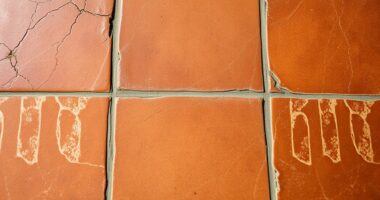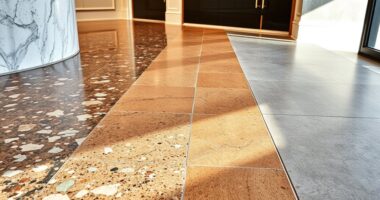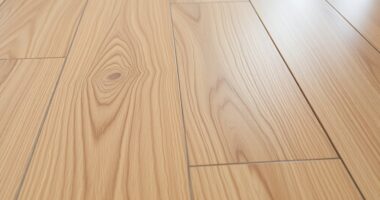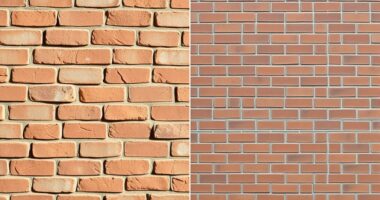Cantera stone is an excellent choice for desert homes because it’s durable, weather-resistant, and adds natural warmth and texture. Its porous nature requires regular sealing, but it performs well in extreme heat and temperature swings. While softer than some stones, it offers flexibility for design and unique aesthetic appeal. However, sourcing quality cantera can be challenging and maintenance is ongoing. To understand how to maximize its benefits and minimize drawbacks, consider exploring further details.
Key Takeaways
- Cantera’s natural thermal stability and weather resistance make it ideal for desert homes exposed to extreme temperatures.
- Its porous nature requires regular sealing to prevent moisture absorption and surface erosion in outdoor environments.
- Cantera adds warmth and aesthetic appeal through its natural textures and color variations, enhancing desert landscape integration.
- The stone’s weight and softness demand careful installation and maintenance, potentially increasing costs and complexity.
- Sourcing high-quality cantera can be challenging, affecting durability, availability, and overall project costs.

Cantera stone has become a popular choice for desert homes due to its exceptional durability and natural aesthetic appeal. This volcanic rock, mainly composed of volcanic ash and lava, offers a unique combination of strength and visual character that resonates with the rugged desert environment. When considering cantera for your property, it’s important to understand its inherent qualities and how they translate into real-world applications. Its high porosity means it can absorb moisture, which might lead to staining or weathering over time if not properly sealed or maintained. However, with appropriate treatment, this porosity can be managed effectively, ensuring longevity without compromising its natural beauty. Its ability to withstand extreme temperature fluctuations makes it particularly suitable for desert climates, where rapid heating and cooling are common. This thermal stability minimizes cracking and deterioration, ensuring that structures built with cantera remain intact over decades. Additionally, cantera’s weather resistance allows it to perform well despite harsh environmental conditions.
From a structural perspective, cantera’s density contributes to its load-bearing capacity, making it a viable material for both exterior facades and interior features. Its ease of carving and shaping allows for intricate detailing, which can enhance architectural aesthetics if you seek a handcrafted or rustic appearance. Yet, this same softness compared to harder stones implies that cantera may be more susceptible to surface chipping or erosion if subjected to harsh impacts or abrasive cleaning methods. For aesthetic integration, the stone’s natural color palette ranges from warm tans to rich browns, blending seamlessly with desert landscapes and complementing earthy color schemes. This visual harmony elevates the overall design, reinforcing a connection to the environment while adding a sense of warmth and authenticity.
However, cantera’s porous nature necessitates regular sealing, especially in areas exposed to water or high humidity, to prevent staining and degradation. Maintenance routines involve periodic sealing and gentle cleaning, which can add to ongoing costs and effort. Additionally, sourcing high-quality cantera can pose challenges; inconsistent availability and variable quality can influence both price and performance. You should also consider the weight of the stone, which affects installation logistics and foundation requirements, especially for larger structures.
Cantera’s porosity requires regular sealing and careful sourcing to ensure lasting beauty and performance.
In terms of application, cantera is versatile—ideal for decorative facades, fireplaces, accent walls, and even outdoor paving. Its natural color variations and texture lend a distinctive character that can be customized to suit diverse design preferences. When used thoughtfully, cantera enhances both the aesthetic and functional aspects of desert homes, providing a durable, visually appealing, and contextually appropriate material choice. However, understanding its limitations and committing to proper maintenance ensures you maximize its benefits, safeguarding your investment and preserving its natural charm over time.
Frequently Asked Questions
How Does Cantera Stone Perform in Extreme Desert Temperature Fluctuations?
Cantera stone handles extreme desert temperature fluctuations well due to its natural thermal properties, which help it absorb and release heat gradually. This minimizes thermal stress and cracking, maintaining its integrity over time. However, prolonged exposure to high heat can cause surface fading or slight deterioration if not properly sealed. You should regularly apply a protective sealant and ensure proper installation to optimize its performance in harsh desert conditions.
Is Cantera Stone Environmentally Sustainable for Desert Home Construction?
Cantera stone can be environmentally sustainable for desert homes if sourced responsibly from local quarries, reducing transportation emissions and supporting local economies. Its natural composition minimizes chemical treatments and synthetic additives, making it a eco-friendly building material. However, you should consider the quarrying impact, potential overextraction, and the stone’s durability, which influences longevity and maintenance needs. Proper sourcing and responsible consumption are key to ensuring cantera’s sustainability benefits.
What Maintenance Does Cantera Stone Require in Arid Climates?
Cantera stone in arid climates demands regular sealing to prevent moisture loss, much like a shield guarding against the harsh sun. You should clean it with gentle, pH-balanced solutions and avoid harsh chemicals that can deteriorate its surface. Inspect regularly for cracks or chips, and reseal every 1-2 years to maintain its appearance and integrity. Proper maintenance guarantees your cantera stone remains a resilient, beautiful addition to your desert home.
Can Cantera Stone Be Used for Outdoor Furniture in Desert Environments?
Yes, cantera stone can be used for outdoor furniture in desert environments, but you should consider its porosity and susceptibility to weathering. Applying a proper sealant enhances durability and protects against sand, sun, and temperature fluctuations. Regular maintenance, like resealing every couple of years, ensures longevity. Its natural aesthetic complements desert landscapes, but understanding its limitations helps you make an informed decision about its suitability for outdoor furniture.
Are There Specific Sealing Techniques for Cantera Stone in Desert Homes?
Yes, there are specific sealing techniques for cantera stone in desert homes. You should apply a high-quality, penetrating sealer designed for natural stone, ensuring even coverage to prevent moisture absorption and UV damage. Re-seal annually to maintain protection, especially in harsh, dry environments. Proper sealing preserves the stone’s appearance, enhances durability, and minimizes staining, making it ideal for outdoor use in desert climates.
Conclusion
While cantera stone offers natural beauty and excellent insulation, its porous nature demands regular maintenance in desert climates. You benefit from its aesthetic appeal, yet face potential challenges with durability against harsh weather. This juxtaposition highlights that, despite its visual charm, cantera requires careful consideration of environmental factors. Ultimately, weighing its pros and cons helps you decide if its timeless elegance aligns with your home’s resilience needs in the desert.









